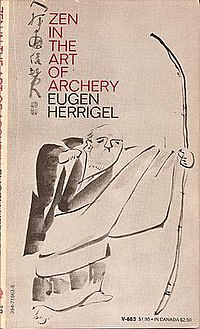Zen in the Art of Archery
From Wikipedia, the free encyclopedia
| Zen in the Art of Archery | |
 |
|
| Author | Eugen Herrigel |
|---|---|
| Cover artist | Joseph del Gaudio |
| Country | Germany |
| Language | German |
| Genre(s) | Philosophical novel |
| Publisher | Pantheon Books Vintage Books |
| Publication date | 1948 (Germany), 1953 (US), 1955 (Japan) |
| Media type | print (hardcover and paperback) |
| Pages | 90 pp (1953 edition, paperback) |
| ISBN | ISBN 53-9945 (1971 edition, hardback) |
Zen in the Art of Archery is a short book written by Eugen Herrigel which brought Zen to Europe after World War II. The book was first published in 1948, in Germany.
Contents |
[edit] Author
Herrigel (1884–1955) was a German professor of philosophy, with a special interest in mysticism. From 1924 to 1929 he taught philosophy in Japan, and studied Kyūdō (the art of the Japanese bow) under a master named Awa Kenzô. Awa taught kyūdō in a way that was regarded by some as a mystical religion, called Daishadokyo. Daishadokyo was an approach to kyūdō that placed great emphasis on the spiritual aspect and differed from much of the mainstream practice at the time.[1] In 1936, Herrigel wrote a 20-page essay about his experiences, and then in 1948 expanded the essay into a short book. The book was translated into English in 1953 and Japanese in 1955.
[edit] Book
Regardless of whether the book is an accurate portrayal of Zen Buddhism or traditional Japanese archery (kyūdō), it is well liked by many and has been a bestseller for more than fifty years. Many of the ideas in the book have become fundamental tenets of how Westerners view Zen Buddhism. One example is the idea that a devotee studies simple tasks for many years at the feet of a master, before being allowed to do more substantial tasks. These perhaps mistaken ideas of Zen and kyūdō being synonymous have gained some interest in Japan, and especially in the west, with schools devoted to "Zen archery."
The book contains accurate ideas about motor learning and control, that provide useful lessons for learning any sport or physical activity. For example, a central idea in the book is that through years of practice, a physical activity becomes effortless both mentally and physically, as if the body executes complex and difficult movements without conscious control from the mind.
Herrigel describes Zen in archery as follows: "The archer ceases to be conscious of himself as the one who is engaged in hitting the bull's-eye which confronts him. This state of unconscious is realized only when, completely empty and rid of the self, he becomes one with the perfecting of his technical skill, though there is in it something of a quite different order which cannot be attained by any progressive study of the art..."
[edit] Influences
The title "Zen in the Art of Archery" inspired a series of other titles. More than 200 books now have similar titles, including Robert Pirsig's 1974 widely popular book Zen and the Art of Motorcycle Maintenance, and more recently Ray Bradbury's "Zen in the Art of Writing," as well as "Zen and the Art of Poker,", "Zen and the Art of Knitting", and Crazy Legs Conti: Zen and the Art of Competitive Eating, and so on. The common theme is usually that doing an ordinary task, such as fixing your motorcycle, can have a spiritual dimension.
[edit] References
- ^ "The Myth of Zen in the Art of Archery" (PDF). Japanese Journal of Religious Studies, 2001, 28/1-2. http://www.nanzan-u.ac.jp/SHUBUNKEN/publications/jjrs/pdf/586.pdf. Retrieved on June 13 2006.
[edit] External links
- Herrigel, Eugen. Zen in the Art of Archery ISBN 0-679-72297-1.
- Yamada Shôji, "The Myth of Zen in the Art of Archery." Japanese Journal of religious studies, Spring 2001, 28/1–2. (Number 586). Alternate point of view. full-text PDF 265K
- "Zen in the Art of Archery - A practitioner's View", Liam O'Brien, Kyoshi 7 dan full-text PDF
- Zen in the Art of Archery - Book Review at the Open Critic

